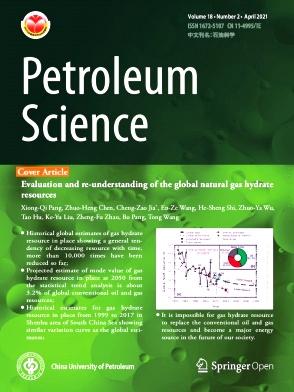多尺度波致流体流动对周期性层状多孔-裂隙介质中地震频散、衰减和频率相关各向异性的影响
IF 6
1区 工程技术
Q2 ENERGY & FUELS
引用次数: 0
摘要
波致流体流动(WIFF)发生在普遍存在的层状多孔介质(如页岩)中,通常会引起明显的地震能量耗散,从而导致波速(即频散)和弹性各向异性参数的频率依赖性。相关知识对页岩孔隙储层的流体判别和油气勘探具有重要意义。基于周期性层状模型和各向异性Biot理论,同时考虑微观喷射流体流动、介观层间流体流动和宏观全局流体流动的影响,推导了具有垂直对称轴(VTI)的周期性层状横向各向同性介质(PLPC介质)的波动方程。值得注意的是,在环形裂缝和刚性孔隙之间出现微观喷射缩短流体流动,产生一个衰减峰。具体而言,我们首先建立了PLPC介质的应力-应变关系和孔隙流体压力,然后利用它们,利用牛顿第二定律推导出波动方程。对波动方程进行平面分析,得到了快p波、慢p波、sv波和sh波四种波的相速度和衰减系数的解析解,从而计算出各向异性参数。仿真结果表明,纵波速度在整个频段内存在三个衰减峰,分别对应层间流、喷射流和Biot流的影响。通过不同入射角下的地震速度频散和衰减结果,我们发现WIFF机制对中低频弹性各向异性参数的频散特性也有显著影响。此外,层厚比、裂缝长径比和裂缝密度等孔隙弹性参数对地震频散和衰减有显著影响。我们将提出的模型速度与现有理论给出的速度进行了比较,以证实其有效性。通过综合考虑微、中观和宏观尺度WIFF机制的影响,我们的公式和结果可以更好地理解波在PLPC介质中的传播,为地震解释奠定了岩石物理的理论基础。本文章由计算机程序翻译,如有差异,请以英文原文为准。
Effects of multi-scale wave-induced fluid flow on seismic dispersion, attenuation and frequency-dependent anisotropy in periodic-layered porous-cracked media
The wave-induced fluid flow (WIFF) occurring in the ubiquitous layered porous media (e.g., shales) usually causes the appreciable seismic energy dissipation, which further leads to the frequency dependence of wave velocity (i.e., dispersion) and elastic anisotropy parameters. The relevant knowledge is of great importance for geofluid discrimination and hydrocarbon exploration in the porous shale reservoirs. We derive the wave equations for a periodic layered transversely isotropy medium with a vertical axis of symmetry (VTI) concurrently with the annular cracks (PLPC medium) based on the periodic-layered model and anisotropic Biot's theory, which simultaneously incorporate the effects of microscopic squirt fluid flow, mesoscopic interlayer fluid flow and macroscopic global fluid flow. Notably, the microscopic squirt shorten fluid flow emerges between the annular-shaped cracks and stiff pores, which generates one attenuation peak. Specifically, we first establish the stress-strain relationship and pore fluid pressure in a PLPC medium, and then use them to derive the wave equations by means of the Newton's second law. The plane analysis is implemented on the wave equations to yield the analytic solutions for phase velocities and attenuation factors of four waves, namely, fast P-wave, slow P-wave, SV-wave and SH-wave, and the anisotropy parameters can be therefore computed. Simulation results show that P-wave velocity have three attenuation peaks throughout the full frequency band, which respectively correspond to the influences of interlayer flow, the squirt flow and the Biot flow. Through the results of seismic velocity dispersion and attenuation at different incident angles, we find that the WIFF mechanism also has a significant impact on the dispersion characteristics of elastic anisotropy parameters within the low-mid frequency band. Moreover, it is shown that several poroelastic parameters, such as layer thickness ratio, crack aspect ratio and crack density have notable influence on seismic dispersion and attenuation. We compare the proposed modeled velocities with that given by the existing theory to confirm its validity. Our formulas and result can provide a better understanding of wave propagation in PLPC medium by considering the unified impacts of micro-, meso- and macro-scale WIFF mechanisms, which potentially lays a theoretical basis of rock physics for seismic interpretation.
求助全文
通过发布文献求助,成功后即可免费获取论文全文。
去求助
来源期刊

Petroleum Science
地学-地球化学与地球物理
CiteScore
7.70
自引率
16.10%
发文量
311
审稿时长
63 days
期刊介绍:
Petroleum Science is the only English journal in China on petroleum science and technology that is intended for professionals engaged in petroleum science research and technical applications all over the world, as well as the managerial personnel of oil companies. It covers petroleum geology, petroleum geophysics, petroleum engineering, petrochemistry & chemical engineering, petroleum mechanics, and economic management. It aims to introduce the latest results in oil industry research in China, promote cooperation in petroleum science research between China and the rest of the world, and build a bridge for scientific communication between China and the world.
 求助内容:
求助内容: 应助结果提醒方式:
应助结果提醒方式:


